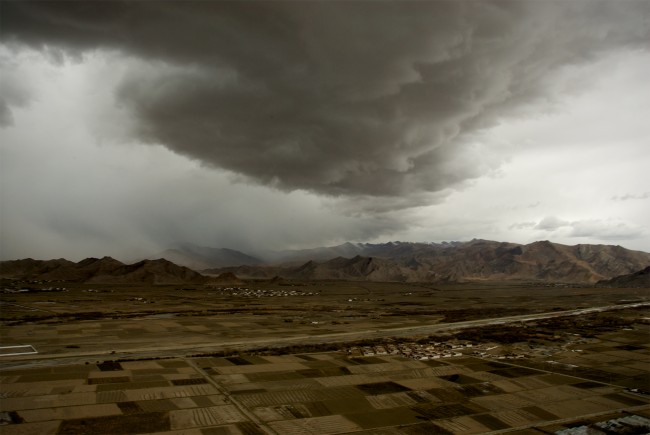Situated at an average of 14,700 feet above sea level, Tibet is the region of the globe with the highest elevation worldwide. When talking about Tibet, I refer to Xizang, or the Autonomous region of Tibet which represents roughly half the size of the Tibetan cultural area. Neighbouring provinces have absorbed some of its original territories after the land reform of 1965. I visited Tibet at the end of April through the beginning of May, the perfect period for travel in what can be climatically a very inhospitable place. At this time of year the climate is relatively stable and dry with clear skies. Nights are cold but during daytime only a light sweater is needed.
I recommend traveling to Tibet by train, if not the entire distance from Beijing, at least from Xining in Qinghai province. Xining itself is a good place to start to familiarize with the omnipresence that Buddhism has in these regions of China manifesting itself it the architecture of temples, its influence in culture and everyday life, and last but not least in the orange robe clad monks walking in the streets. Passing altitudes as high as 16,640 feet, the 2006 completed Qinghai-Tibet railway is truly a masterpiece in the art of engineering. Book well ahead to get a ticket for the night train. You will wake up in the middle of an amazing landscape with stunning views of high plateaus covered with snow. The train compartments are equipped with oxygen nozzles should the high altitude make you dizzy.
Before the journey through rural Tibet our travel group spent three days in Lhasa both for sightseeing and acclimatization. Paying a visit to Potala Palace in the heart of Lhasa, its inner city made up of vibrant markets mixed with religious sites, we encountered an endless procession of pilgrims and monks. In the Dalai Lama’s former summer residence time seems to stand still ever since he fled to India in 1959.
Travel agencies offering a variety of routes through the province my small group chose to go to the north passing Yomdrok lake, visiting the towns of Gyantse, Shigatse, Dingri, Rongphu and the Mount Everest basecamp, with Zhangmu, a Chinese border town to Nepal out final destination.
The impression that you have come to a very special part of the planet while still on the train, this feeling fully materializes when you’re in the heart of Tibet. The mountain ranges with all their 25,000 plus peaks – some of which you partially climb in vehicles going over some of the world´s highest passes – are some of the most breath-taking scenes I’ve ever had before my eyes and my camera lens.
Crystal clear mountain lakes reflecting their surroundings like mirrors, heavy clouds hanging in the sky, and people looking as tough and marked as the environment they live in add an unreal touch to the dramatic scenery. Having spent a couple of days letting my mind settle down while listening to the sounds of the bells and chanting of the Buddhist monks while watching them performing their rituals, I’m ready for one of the highlights of the tour – the ascent to Basecamp No. 1 of the world´s highest mountain, Mount Everest. Getting onto a 4wheel drive 4 in the morning after having spent a short night in a small village located very close to the entrance to the national park, I have my first mind-boggling moment seeing the mountain range of three 25,000ers with Mount Everest in their center. The dawn light with the first sunbeams illuminating them makes these magnificent peaks glow as if flames in a fire. Among the many highlights of the day is lunch next to Rhongphu monastery, the one portrayed being washed away in the apocalyptic movie “2012”.
The closing chapter of this journey is the 12-hour drive to Zhangmu which is no less interesting than the rest of the journey. After crossing the last high pass after seemingly never-ending serpentine turns, we arrive with memories and photographs of perhaps the most magical parts of our shared planet.
Photo Credits
All Photographs Are © Emanuel Luttersdorfer
Emanuel Luttersdorfer Photographer Bio
 Emanuel Luttersdorfer is a medical doctor who has been born and growing up in Austria. He is currently working as a General Practitioner in an International clinic in Beijing, PRC. His interest in foreign cultures and places has led him to study Tropical Medicine in Thailand where he has been living for a year and which has been the starting point of his life as an expat in Asia. Equipped with his camera, fund knowledge about basic photography and an open mind he is exploring the world always looking for that special thing to see. So far his journeys have taken him to many locations all over the world but fortunately there are still lots of adventures to be lived and places left to be explored by him.
Emanuel Luttersdorfer is a medical doctor who has been born and growing up in Austria. He is currently working as a General Practitioner in an International clinic in Beijing, PRC. His interest in foreign cultures and places has led him to study Tropical Medicine in Thailand where he has been living for a year and which has been the starting point of his life as an expat in Asia. Equipped with his camera, fund knowledge about basic photography and an open mind he is exploring the world always looking for that special thing to see. So far his journeys have taken him to many locations all over the world but fortunately there are still lots of adventures to be lived and places left to be explored by him.
Website: Luttersdorfer.com
Follow Emanuel Luttersdorfer on: Facebook | Linkedin





very good article, and magnificent pictures! quite helpful for my next year trip there~
Amazing story and photos! I felt like I was along for the adventure!!